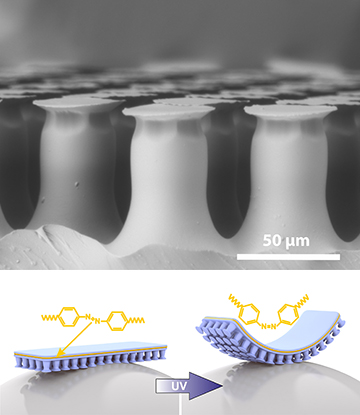
Mushroom-shaped micropillars with adhesive tips (top) provide the “stickiness factor” for the material, inspired by the microstructures in geckos’ feet. Under the influence of UV light, the material reversibly bends back, peeling away the adhesive micropillar tips and allowing the attached item to fall off (bottom). [Images: Emre Kizilkan and Jan Strueben]
Geckos, the diminutive lizards famous for their ability to walk on walls and ceilings, achieve their gravity-defying feats via spatula-shaped nanostructures on their toes. A team of scientists from Kiel University and the University of Bremen, Germany, has now used that biological example to create an artificial analog capable of grabbing onto macroscopic materials and subsequently “unsticking” to drop off the cargo on cue at another location—all at the flip of a light switch (Sci. Robot., doi: 10.1126/scirobotics.aak9454). The researchers believe that the material’s combination of photocontrol and versatility could make it useful for transportation applications in robotics and industrial processes.
Wanted: A photocontrollable “gecko’s foot”
In the gecko example, the actions of the lizard itself are what turn the toes’ adhesion on and off: The nanostructures in the toes, nonsticky by default, can be switched to a sticky molecular state through shear stress transmitted from the gecko’s legs as it moves. Previous workers have developed analog materials whose adhesiveness can be switched on mechanically, magnetically or thermally. But a material that could achieve the same selective stickiness with a light switch potentially has significant advantages, since light can be controlled rapidly and precisely in a wide variety of application settings.
To develop such a light-responsive adhesive, the German team zeroed in on cross-linked liquid crystal elastomers (LCEs) spiked with the chemical azobenzene. One characteristic of that chemical is its photoisomerization: specifically, its molecules convert, in mere picoseconds, into a tighter, kinked form when illuminated by ultraviolet (UV) light at a wavelength from 320 to 380 nm, and then relax to their original shape when illuminated by visible light from 420 to 480 nm. The researchers reasoned that this characteristic, embedded in the right microstructure, could create a light-activated micromuscle that could selectively grab onto an object and then release it under light-driven cues.
Mushroom-shaped pillars
The team fashioned its “bioinspired photocontrollable microstructured transport device”—which they identify with the acronym BIPMTD—in three 100-μm-thick layers: a top layer consisting of an array of mushroom-shaped, adhesive micropillars in a polydimethylsiloxane (PDMS) base; a middle layer with an LCE film containing the photocontrolling azobenzene; and a lower backing layer of PDMS. The material, in its flat state, is sticky by default, as the adhesive micropillar tips can grab onto a large surface area.
When exposed to UV light, however, the material arches back as the azobenzene in the LCE film layer switches to the more compact, kinked isomer. As the material curves, the PDMS pillar “suction cups” holding onto the attached object pop off, reducing the contact surface area until the object itself drops away. The entire process takes a matter of seconds—and when the UV light is switched off, the adhesive surface quickly resumes its original shape, ready for the next load of cargo.
Tunable stickiness?
The team used the system to grab onto and subsequently release objects including glass lab slides, laboratory tubes, and glass spheres—an indication that the system can handle both “planar and 3-D solid objects,” according to the scientists. Their experiments also suggested that the material’s curvature, and thus its degree of adhesion, can be tuned by varying the intensity of the UV light.
The team notes that the photoswitchable material could prove particularly useful in industrial applications, in which working temperatures tend to span a wide range and thermally switchable approaches are less practical. “We believe,” the study concludes, “that the BIPMTD is suitable for the transportation of planar and nonplanar objects of different sizes for technological areas ranging from robotics to … industrial micromanipulation tools.”

